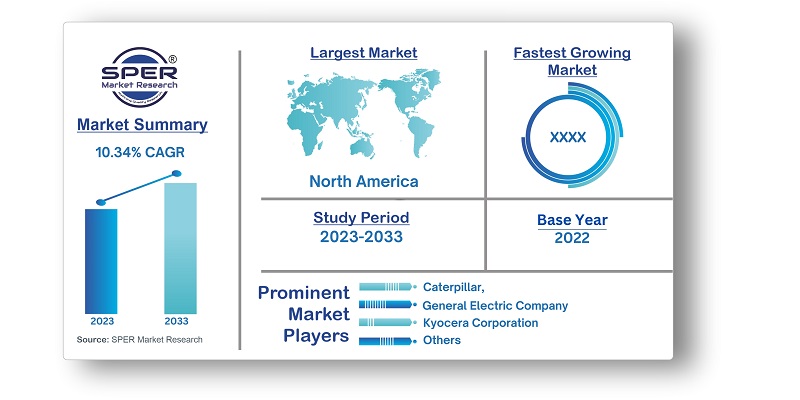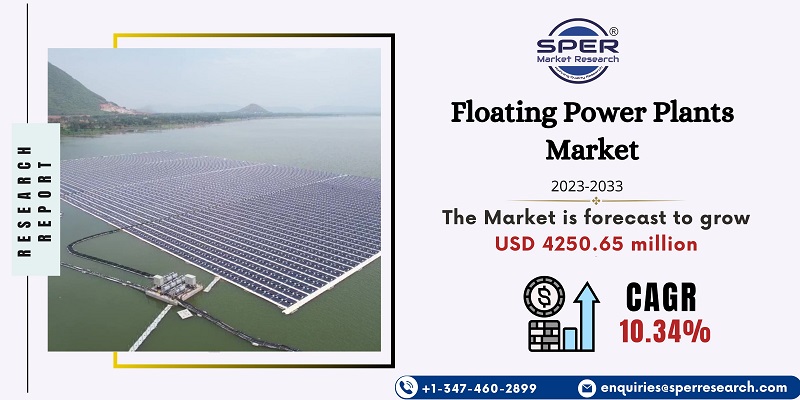
Floating Power Plants Market Growth, Trends, Size, Revenue, Share, Demand and Future Outlook
Floating Power Plants Market Size- By Power Source, By Power Rating, By Platform Type- Regional Outlook, Competitive Strategies and Segment Forecast to 2033
| Published: Dec-2023 | Report ID: POAE2387 | Pages: 1 - 210 | Formats*: |
| Category : Power & Energy | |||
- A fourth iteration of Principle Power's Wind Float concept was unveiled with the goal of lowering industrial costs and enabling supply chain participation in areas with varying fabrication capacities and port characteristics.
- NTPC declared in March 2019 that the construction of its 1 MW grid-connected floating solar power plant in Gujrat was almost finished. For the past six months, this power plant has been under construction. The NTPC Director, Debashish Das, declared that this power plant would be put into service in April 2019.


| Report Metric | Details |
| Market size available for years | 2019-2033 |
| Base year considered | 2022 |
| Forecast period | 2023-2033 |
| Segments covered | By Power Source, By Power Rating, By Platform Type |
| Regions covered | North America, Asia-Pacific, Latin America, Middle East & Africa and Europe |
| Companies Covered | Burmeister & Wain Scandinavian Contractor A/S, Caterpillar, Inc., Ciel & Terre International, Floating Power Plant A/S, General Electric Company, Ideol, Kyocera Corporation, MAN Diesel & Turbo SE, Mitsubishi Corporation, SeaTwirl AB, Siemens AG, Vikram Solar Pvt., Ltd., Others |
- Renewable Energy Developers
- Energy Utilities and Operators
- Investors and Financiers
- Government and Regulatory Bodies
- Technology Providers
| By Power Source: |
|
| By Power Rating: |
|
| By Platform Type: |
|
- Global Floating Power Plants Market Size (FY’2023-FY’2033)
- Overview of Global Floating Power Plants Market
- Segmentation of Global Floating Power Plants Market By Power Source (Non-renewable, Renewable)
- Segmentation of Global Floating Power Plants Market By Power Rating (High, Medium, Low)
- Segmentation of Global Floating Power Plants Market By Platform Type (Floating Structures, Power Barges, Power Ships)
- Statistical Snap of Global Floating Power Plants Market
- Expansion Analysis of Global Floating Power Plants Market
- Problems and Obstacles in Global Floating Power Plants Market
- Competitive Landscape in the Global Floating Power Plants Market
- Impact of COVID-19 and Demonetization on Global Floating Power Plants Market
- Details on Current Investment in Global Floating Power Plants Market
- Competitive Analysis of Global Floating Power Plants Market
- Prominent Players in the Global Floating Power Plants Market
- SWOT Analysis of Global Floating Power Plants Market
- Global Floating Power Plants Market Future Outlook and Projections (FY’2023-FY’2033)
- Recommendations from Analyst
1.1. Scope of the report1.2. Market segment analysis
2.1. Research data source
2.1.1. Secondary Data2.1.2. Primary Data2.1.3. SPER’s internal database2.1.4. Premium insight from KOL’s
2.2. Market size estimation
2.2.1. Top-down and Bottom-up approach
2.3. Data triangulation
4.1. Driver, Restraint, Opportunity and Challenges analysis
4.1.1. Drivers4.1.2. Restraints4.1.3. Opportunities4.1.4. Challenges
4.2. COVID-19 Impacts of the Global Floating Power Plants Market
5.1. SWOT Analysis
5.1.1. Strengths5.1.2. Weaknesses5.1.3. Opportunities5.1.4. Threats
5.2. PESTEL Analysis
5.2.1. Political Landscape5.2.2. Economic Landscape5.2.3. Social Landscape5.2.4. Technological Landscape5.2.5. Environmental Landscape5.2.6. Legal Landscape
5.3. PORTER’s Five Forces
5.3.1. Bargaining power of suppliers5.3.2. Bargaining power of buyers5.3.3. Threat of Substitute5.3.4. Threat of new entrant5.3.5. Competitive rivalry
5.4. Heat Map Analysis
6.1. Global Floating Power Plants Market Manufacturing Base Distribution, Sales Area, Product Type6.2. Mergers & Acquisitions, Partnerships, Product Launch, and Collaboration in Global Floating Power Plants Market
7.1. Global Floating Power Plants Market Value Share and Forecast, By Power Source, 2023-20337.2. Non-renewable7.3. Renewable
8.1. Global Floating Power Plants Market Value Share and Forecast, By Power Rating, 2023-20338.2. High8.3. Medium8.4. Low
9.1. Global Floating Power Plants Market Value Share and Forecast, By Platform Type, 2023-20339.2. Floating Structures9.3. Power Barges9.4. Power Ships
10.1. Global Floating Power Plants Market Size and Market Share
11.1. Global Floating Power Plants Market Size and Market Share By Power Source (2019-2026)11.2. Global Floating Power Plants Market Size and Market Share By Power Source (2027-2033)
12.1. Global Floating Power Plants Market Size and Market Share By Power Rating (2019-2026)12.2. Global Floating Power Plants Market Size and Market Share By Power Rating (2027-2033)
13.1. Global Floating Power Plants Market Size and Market Share By Platform Type (2019-2026)13.2. Global Floating Power Plants Market Size and Market Share By Platform Type (2027-2033)
14.1. Global Floating Power Plants Market Size and Market Share By Region (2019-2026)14.2. Global Floating Power Plants Market Size and Market Share By Region (2027-2033)14.3. Asia-Pacific
14.3.1. Australia14.3.2. China14.3.3. India14.3.4. Japan14.3.5. South Korea14.3.6. Rest of Asia-Pacific
14.4. Europe
14.4.1. France14.4.2. Germany14.4.3. Italy14.4.4. Spain14.4.5. United Kingdom14.4.6. Rest of Europe
14.5. Middle East and Africa
14.5.1. Kingdom of Saudi Arabia14.5.2. United Arab Emirates14.5.3. Rest of Middle East & Africa
14.6. North America
14.6.1. Canada14.6.2. Mexico14.6.3. United States
14.7. Latin America
14.7.1. Argentina14.7.2. Brazil14.7.3. Rest of Latin America
15.1. Burmeister & Wain Scandinavian Contractor A/S
15.1.1. Company details15.1.2. Financial outlook15.1.3. Product summary15.1.4. Recent developments
15.2. Caterpillar, Inc.
15.2.1. Company details
15.2.2. Financial outlook15.2.3. Product summary15.2.4. Recent developments
15.3. Ciel & Terre International
15.3.1. Company details15.3.2. Financial outlook15.3.3. Product summary15.3.4. Recent developments
15.4. Floating Power Plant A/S
15.4.1. Company details15.4.2. Financial outlook15.4.3. Product summary15.4.4. Recent developments
15.5. General Electric Company
15.5.1. Company details15.5.2. Financial outlook15.5.3. Product summary15.5.4. Recent developments
15.6. Ideol
15.6.1. Company details15.6.2. Financial outlook15.6.3. Product summary15.6.4. Recent developments
15.7. Kyocera Corporation
15.7.1. Company details15.7.2. Financial outlook15.7.3. Product summary15.7.4. Recent developments
15.8. MAN Diesel & Turbo SE
15.8.1. Company details15.8.2. Financial outlook15.8.3. Product summary15.8.4. Recent developments
15.9. Mitsubishi Corporation
15.9.1. Company details15.9.2. Financial outlook15.9.3. Product summary15.9.4. Recent developments
15.10. SeaTwirl AB
15.10.1. Company details15.10.2. Financial outlook15.10.3. Product summary15.10.4. Recent developments
15.11. Siemens AG
15.11.1. Company details15.11.2. Financial outlook15.11.3. Product summary15.11.4. Recent developments
15.12. Vikram Solar Pvt., Ltd.
15.12.1. Company details15.12.2. Financial outlook15.12.3. Product summary15.12.4. Recent developments
15.13. Others
SPER Market Research’s methodology uses great emphasis on primary research to ensure that the market intelligence insights are up to date, reliable and accurate. Primary interviews are done with players involved in each phase of a supply chain to analyze the market forecasting. The secondary research method is used to help you fully understand how the future markets and the spending patterns look likes.
The report is based on in-depth qualitative and quantitative analysis of the Product Market. The quantitative analysis involves the application of various projection and sampling techniques. The qualitative analysis involves primary interviews, surveys, and vendor briefings. The data gathered as a result of these processes are validated through experts opinion. Our research methodology entails an ideal mixture of primary and secondary initiatives.



Frequently Asked Questions About This Report
PLACE AN ORDER
Year End Discount
Sample Report
Pre-Purchase Inquiry
NEED CUSTOMIZATION?
Request CustomizationCALL OR EMAIL US
100% Secure Payment






Related Reports
Our Global Clients
Our data-driven insights have influenced the strategy of 200+ reputed companies across the globe.




















